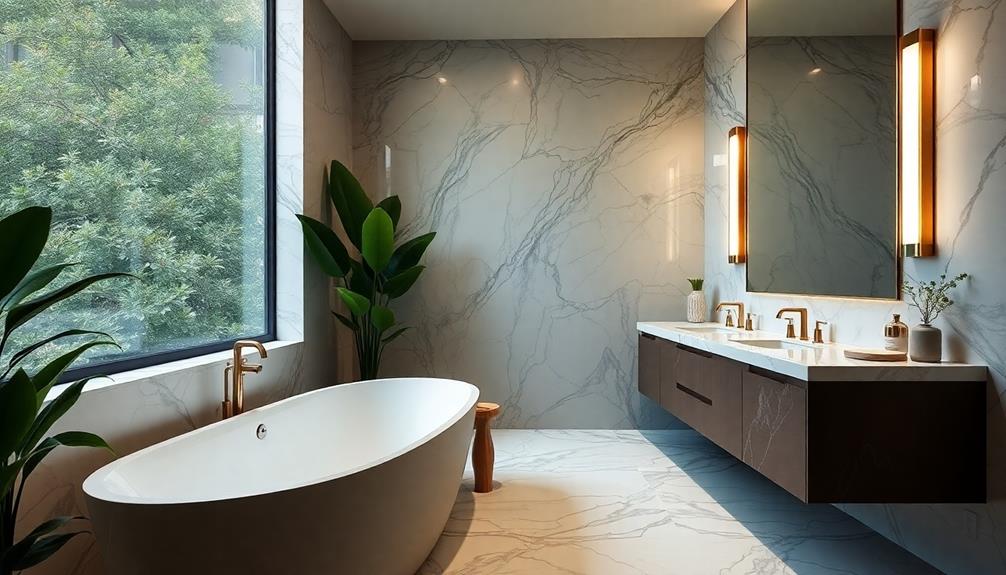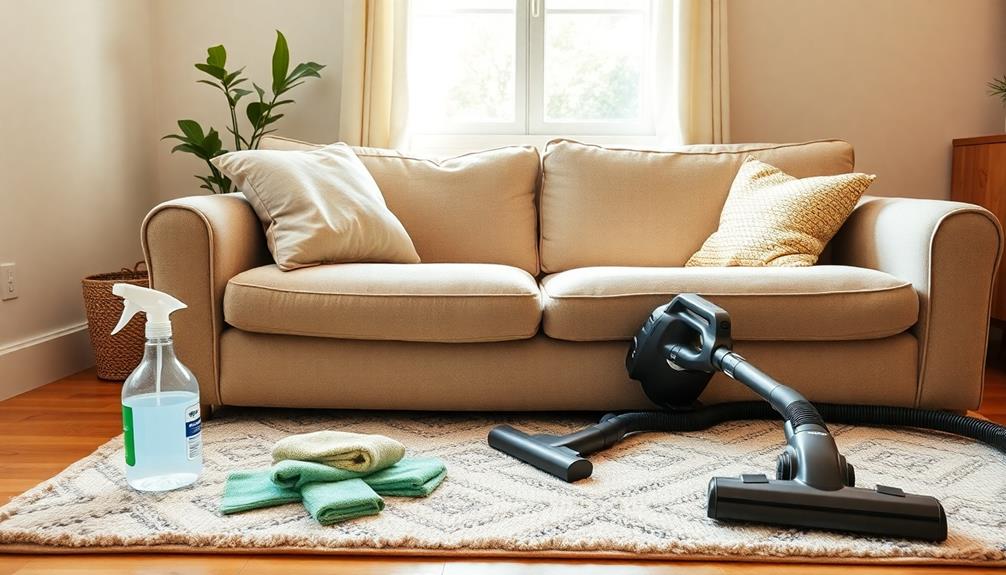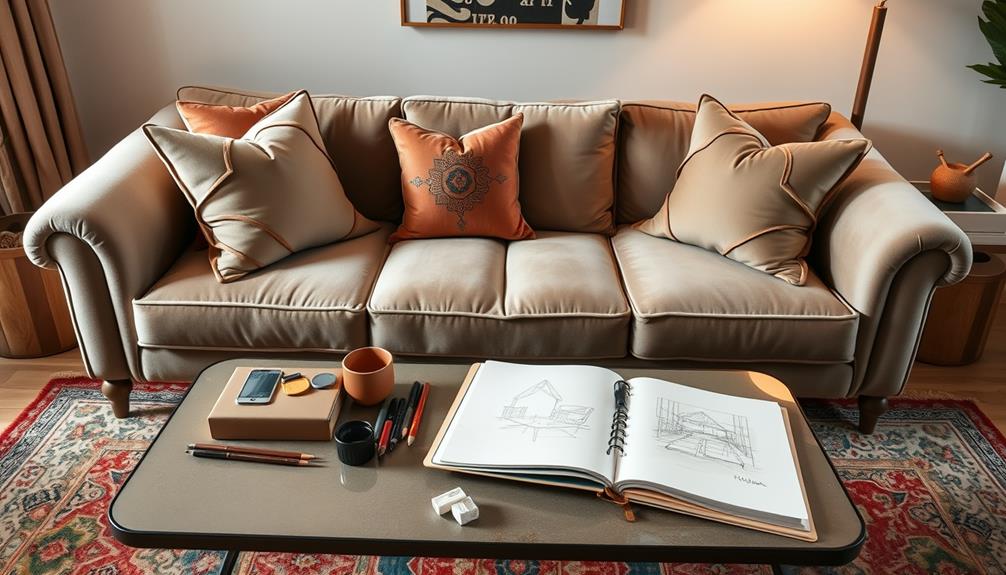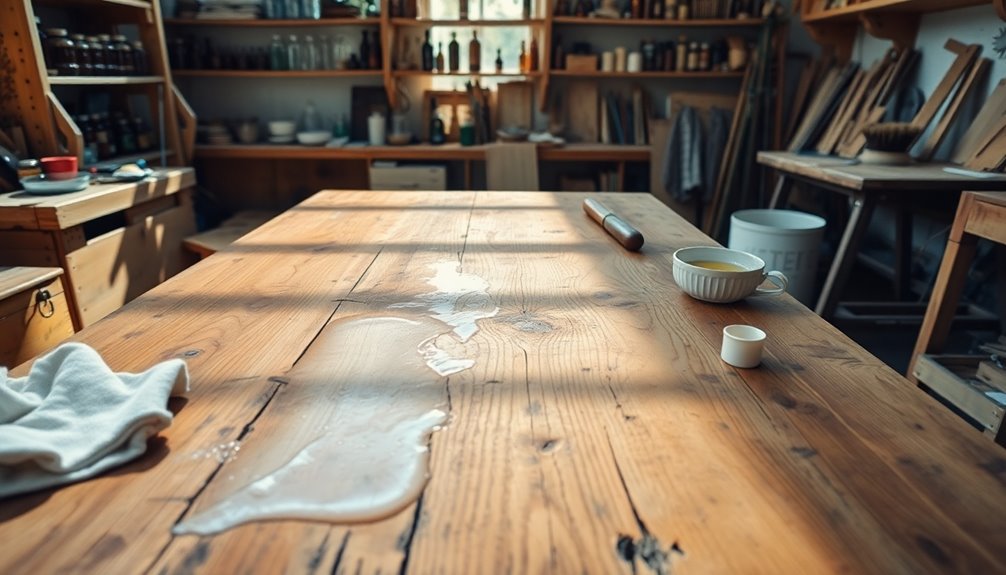To begin planning your bathroom renovation, it’s important to first assess your needs and evaluate the current layout. Identify any functional issues and establish a budget that covers materials and labor costs. Pay attention to design elements such as incorporating relaxation features and smart home technology. Choose high-quality materials that are both waterproof and environmentally friendly for long-lasting durability. Don’t forget to add personal touches like decor and color schemes that reflect your individual style. Use online design tools for visualizing your ideas and be prepared for unexpected challenges along the way. Each step you take will contribute to creating a space that you will truly enjoy—continue exploring for more tips and tricks for your project. Consider looking into innovative bahay kubo designs to bring a unique and culturally inspired element to your bathroom remodel. By integrating natural elements and traditional Filipino architecture, you can achieve a stunning and rejuvenating space. Explore ways to incorporate bamboo, wood, and other sustainable materials to infuse a sense of nature into your bathroom. These design choices will enhance your renovation and result in a truly special and personalized space.
Key Takeaways
- Evaluate the current layout and assess functionality issues to inform your design goals and user requirements.
- Establish a comprehensive budget, factoring in materials, labor, permits, and a reserve for unexpected expenses.
- Choose high-quality, durable materials for flooring and fixtures, while also considering eco-friendly options for sustainability.
- Utilize online design tools for effective visualization and communicate clearly with contractors to ensure alignment on project expectations.
- Anticipate potential delays and maintain flexibility in your plans to manage unexpected issues during the remodel process.
Assessing Your Bathroom Needs
When you commence a bathroom remodel, the first step is evaluating your current space. Look closely at your bathroom layout to identify any functionality issues or areas that feel cramped.
Consider how each family member uses the space; if there are children or elderly individuals, their specific accessibility needs should influence your design. Additionally, it's essential to establish a realistic budget that considers all potential expenses, as this will guide your choices throughout the remodel.
Next, assess your storage needs. Think about whether you have enough cabinetry or shelving to keep your bathroom organized and clutter-free. If not, now's the perfect time to plan for additional storage solutions that fit seamlessly into the layout.
Also, take a moment to evaluate the plumbing and electrical setup. Understanding these elements can help you determine what changes are feasible without blowing your budget, especially if you're thinking about relocating fixtures.
Key Design Concepts
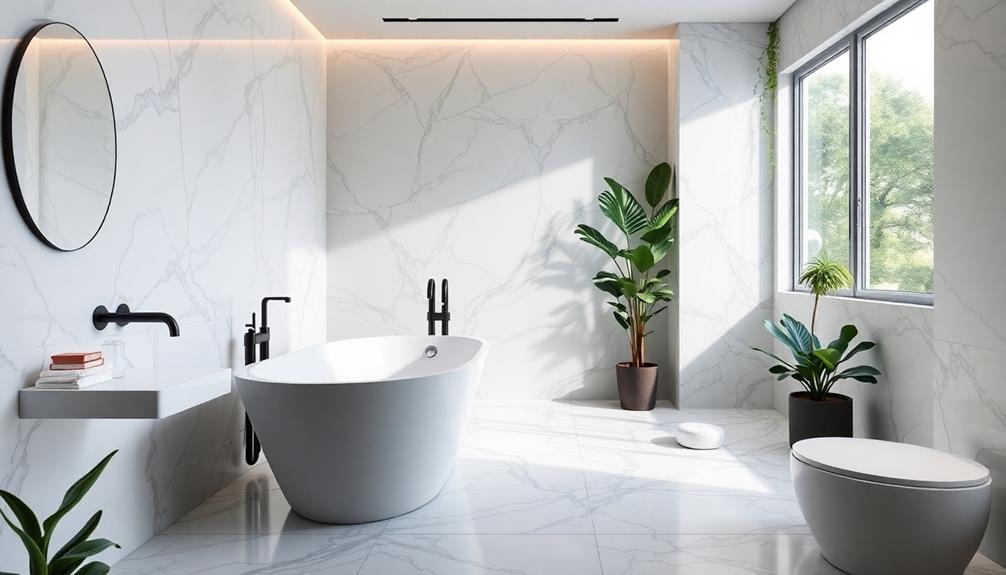
Designing a bathroom remodel involves several key concepts that can transform your space into a functional and stylish oasis.
First, consider the type of bathroom renovation you're planning. Master baths benefit from luxurious elements like freestanding tubs and spacious showers, focusing on both relaxation and functionality. For high-traffic areas, three-quarter baths require efficient layouts that maximize space while accommodating frequent use.
Additionally, financial considerations for elderly care are essential when planning a remodel that accommodates the needs of aging family members.
If you're working with a compact area, a powder room can shine with creative design options. Luxurious touches, even in smaller spaces, elevate the overall aesthetic and make a big impact.
To promote relaxation, explore spa-inspired designs that use serene color palettes, natural materials, and expert lighting to enhance the ambiance.
Don't underestimate the power of unique tile designs. Incorporating unexpected patterns or large format tiles can create visual interest and contribute to a contemporary bathroom atmosphere.
Planning Your Remodel
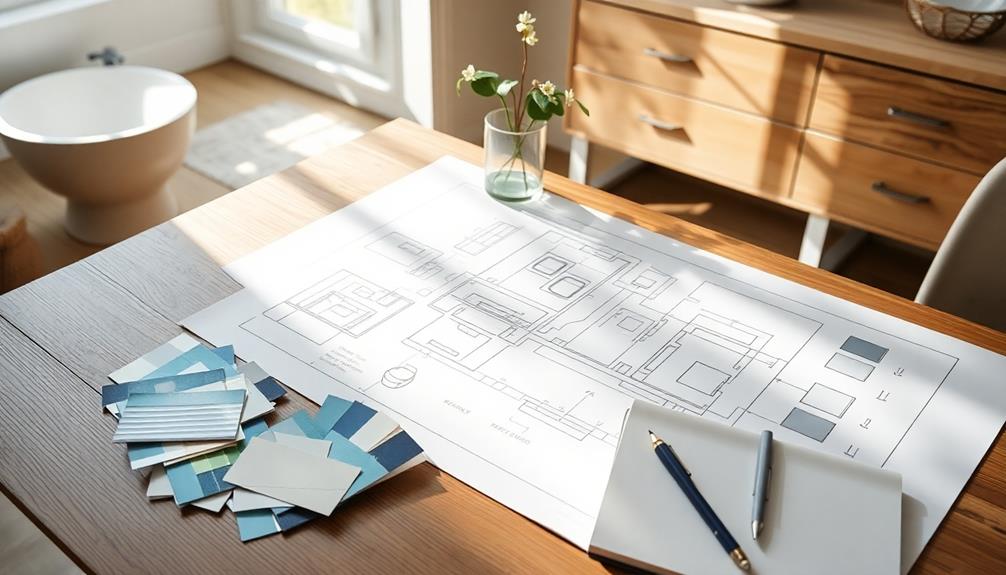
When planning your remodel, start by defining your remodeling goals to guarantee your new space meets your needs.
Consider incorporating key features of a farmhouse bathroom to add charm and functionality.
Next, assess your current bathroom layout to determine any necessary adjustments and space requirements.
Define Remodeling Goals
Setting clear remodeling goals is essential for a successful bathroom renovation. Start by identifying your specific reasons for the bathroom remodel. Are you looking to improve functionality, increase your home's value, or simply update outdated designs? Understanding your motivations will guide your decisions throughout the process.
Consider how DIY Fire Pit Ideas for outdoor spaces might inspire a cohesive style throughout your home, including your bathroom.
Next, assess your current layout, especially if you're working with a small bathroom. Determine which elements need changing based on your family's needs and lifestyle preferences. For example, if you find yourself lacking storage, consider incorporating additional cabinets or shelves.
Set clear goals for your renovation by listing desired features. Do you want a luxurious soaking tub, a spacious walk-in shower, or enhanced storage options?
Prioritize functionality to guarantee the space serves everyone's needs, whether it's family members or guests.
Assess Space Requirements
To guarantee your bathroom remodel meets your needs, start by carefully measuring the existing space. Determine the available square footage and see how it aligns with your design goals.
Think about the number of users and their specific requirements. For example, if you have elderly family members, you might need accessibility features. Families with children may require extra storage. This phase of planning is essential for creating a space that balances beauty with practicality, leading to a bathroom that truly reflects your style and functionality needs.
Consider utilizing mood boards essential for visualizing design concepts during this process.
Next, identify the necessary fixtures and their dimensions, like vanities, toilets, and showers. Verify they fit comfortably within the designated area while allowing for adequate movement. This step is vital in bathroom remodeling since cramped spaces can lead to frustration.
Evaluate layout options based on your current and future needs. Consider whether you should opt for a full bath, half-bath, or powder room to maximize functionality.
Don't forget to factor in plumbing and electrical systems, as well as potential structural changes. These elements can greatly influence your design and how efficiently you utilize space.
Budgeting Considerations
Budgeting for your bathroom remodel is essential to guarantee you stay on track financially and achieve your design goals. Begin by establishing a thorough budget that includes all expenses—materials, labor, permits, and a cushion for unexpected costs.
Generally, a mid-range bath remodel will range from $10,000 to $25,000, depending on your project's scope and location. Consider how high customer service ratings from various service providers can influence your choice of contractors and materials.
Identify areas where you can splurge, like high-quality fixtures or custom cabinetry, while balancing costs with budget-friendly alternatives such as prefabricated vanities or standard tile options. Remember, a minor remodel might cost around $6,000, while a major overhaul could exceed $20,000.
Factor in the potential resale value of your choices; well-planned renovations can yield an ROI of 60% to 70%. Additionally, be prepared for material shortages and price fluctuations that could impact your budget and timeline.
Research and purchase materials in advance to help mitigate these risks. Finally, if you're looking to add extra storage, consider built-ins or shelving that fit within your budget, maximizing both functionality and aesthetics in your new bathroom.
Budgeting for Your Project
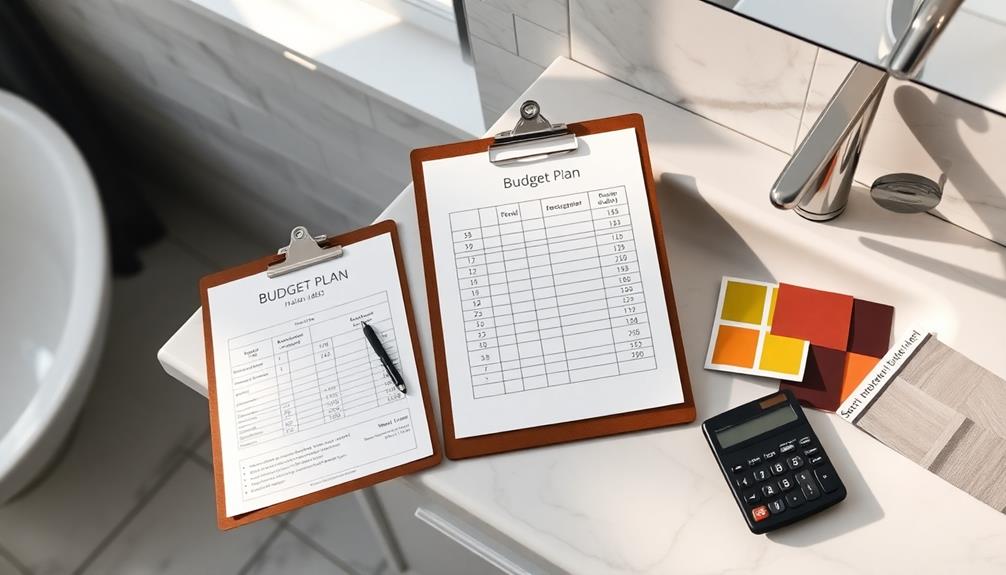
When budgeting for your bathroom remodel, start by creating a thorough plan that includes materials, labor, and permits.
Consider the costs of energy-efficient appliances or fixtures, as investing in these can lead to savings in the long run.
Decide where you want to splurge on high-quality fixtures and where you can save with budget-friendly alternatives. This approach will help you maximize your overall value while keeping unexpected costs in check.
Additionally, looking into market trends and costs can provide valuable insights for your project.
Comprehensive Remodeling Budget
Establishing a thorough remodeling budget is essential for a successful bathroom renovation. Start by evaluating the costs of materials, labor, permits, and any unexpected expenses that might pop up. For a mid-range bathroom remodel, you can expect to spend between $15,000 to $30,000. Research typical renovation costs in your area to get a more accurate estimate.
It's also wise to take into account financial implications similar to those in divorce, such as division of assets, which can affect your overall budget planning. Financial implications in divorce can offer valuable insights into managing your remodeling expenses effectively.
Next, create a detailed remodeling budget by identifying key areas where you can splurge, like high-quality fixtures or flooring, while also pinpointing areas to save, such as choosing stock cabinetry instead of custom designs.
It's wise to factor in an additional 10-20% of your budget for unforeseen issues.
Explore budget-friendly alternatives, like refinishing existing fixtures or selecting affordable tile options, to stretch your budget further.
Remember, your bathroom design ideas should also reflect the long-term resale value. Investing in essential upgrades, like energy-efficient fixtures, can be a smart move when it comes time to sell your home.
With careful planning and a clear budget, you'll create a stunning bathroom that meets your needs and enhances your home's value.
Splurge vs. Save Choices
Determining where to splurge and where to save can make a significant difference in your bathroom remodel's overall success. Start by allocating 25-35% of your total budget for high-quality fixtures and finishes, while also reserving funds for unexpected costs. Prioritize splurging on durable materials like solid wood cabinetry and luxury faucets, but consider budget-friendly options for less visible elements.
Here's a quick guide to help you decide:
| Splurge | Save | Considerations |
|---|---|---|
| Luxury faucets | Basic plumbing supplies | Look for quality vs. cost |
| Solid wood cabinetry | Drywall | Choose aesthetics wisely |
| Premium tile work | Standard tiles | Focus on resale value |
Research local renovation costs to understand market rates, which can guide your decisions. Remember, investing in timeless designs not only enhances your space but can also increase your home's resale value. Look for budget-friendly options like clearance sales or repurposing leftover materials for accents. This way, you can achieve a high-end look without breaking the bank.
Selecting Quality Materials
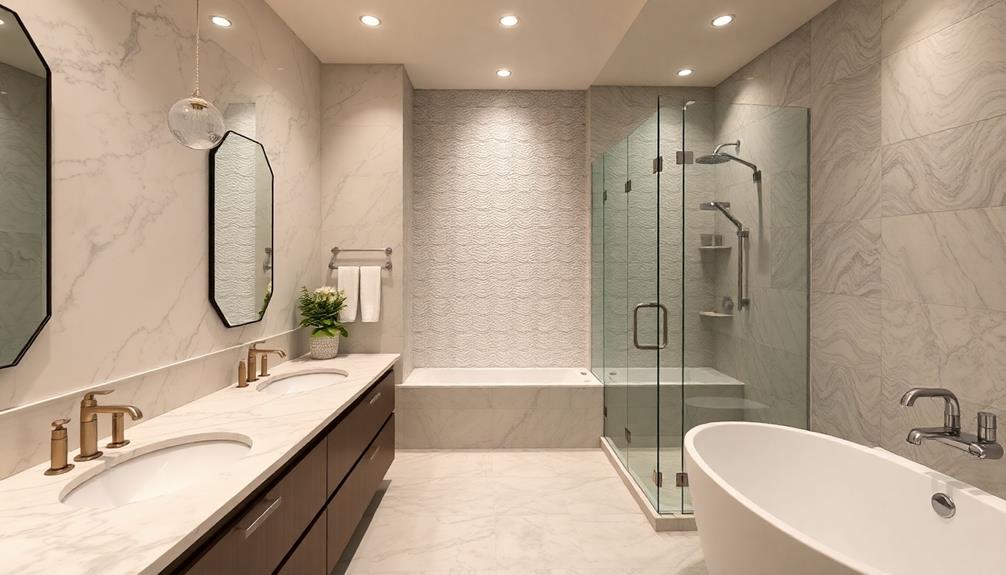
Selecting quality materials for your bathroom remodel is essential for achieving both style and functionality. Start with the flooring; opt for waterproof options like porcelain or ceramic tiles. These materials not only prevent water damage but also provide durability for years to come.
When it comes to fixtures, choose high-quality faucets and showerheads made from solid brass or stainless steel. This choice enhances longevity and resists corrosion, ensuring your fixtures look great over time.
Additionally, consider incorporating smart home technology in your bathroom, such as automated lighting or smart shower systems, which can enhance both convenience and energy efficiency in your space, reflecting the trend of smart home integration.
Don't overlook eco-friendly materials, either. Consider using sustainably sourced bamboo or recycled glass to create a modern aesthetic while promoting sustainability.
For the walls, select a moisture-resistant paint to prevent peeling and mold growth, ensuring your bathroom maintains a fresh look.
Tiling and Installation Process
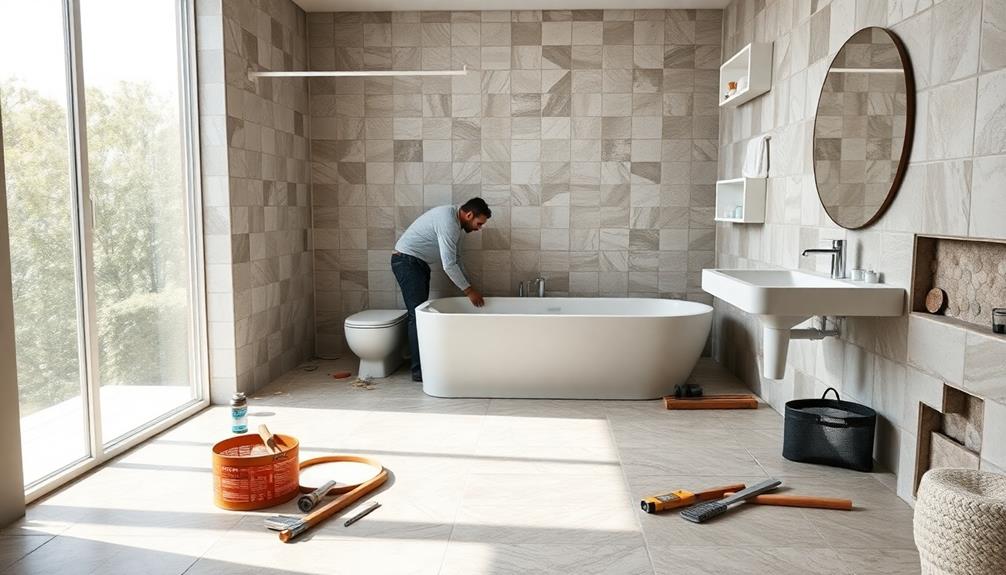
When it comes to tiling your bathroom, understanding the installation process is key to achieving a professional look. Start by choosing the right tiles; smaller tiles are ideal for your shower enclosure floor since they accommodate the necessary drainage gradient.
To enhance your comfort during the remodel, consider using essential oils like peppermint oil for its invigorating scent, which can help alleviate feelings of nausea often associated with home improvement projects. Before you begin, apply a RedGard waterproofing membrane to the wall tiles to protect against moisture damage.
Next, prepare your thin-set mortar. Mix it consistently and apply it quickly to guarantee a strong bond between the tiles and the substrate. This step is essential to prevent future issues with tile adhesion.
If you're using large format tiles, enlist a friend to help with handling and cutting, as their weight and size can make them unwieldy.
Once your tiles are in place, it's time to add grout to fill the gaps between them. This not only enhances the finished look but also protects against water infiltration in the seams.
Finishing Touches
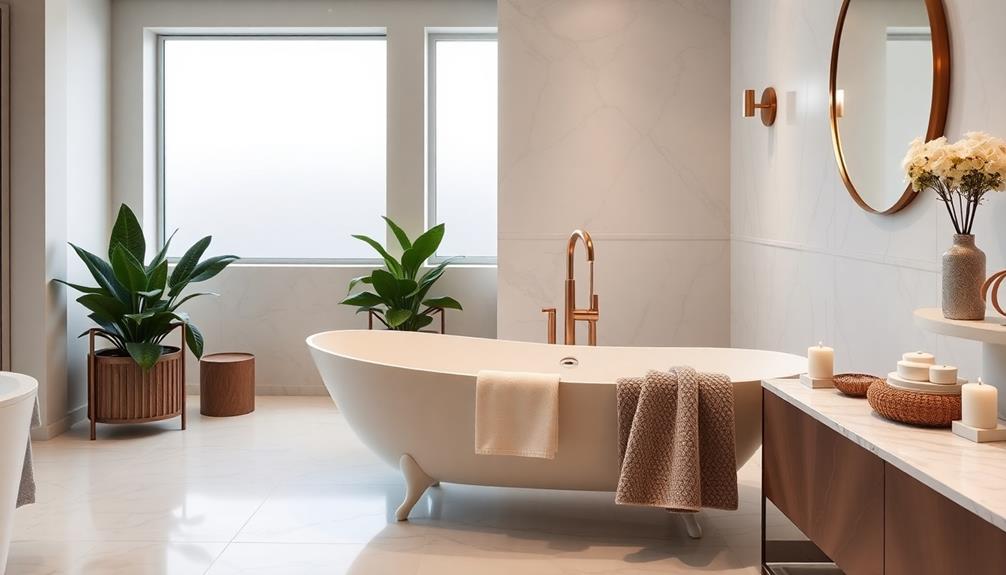
The finishing touches can truly transform your bathroom into a personal oasis. Start by selecting moisture-resistant paint after all major installations are complete. This guarantees durability and minimizes touch-ups.
Consider incorporating smart devices, like motion-sensor lights and smart mirrors, to enhance functionality while adding a modern flair.
Next, focus on decor items that complement your chosen color scheme. Rugs, mirrors, and faucets should harmonize with each other to create an inviting atmosphere.
Don't forget about greenery; adding living plants can bring a revitalizing, natural element to your space. Just make sure to choose low-light-tolerant species to thrive in your bathroom's environment.
Personalizing Your Space
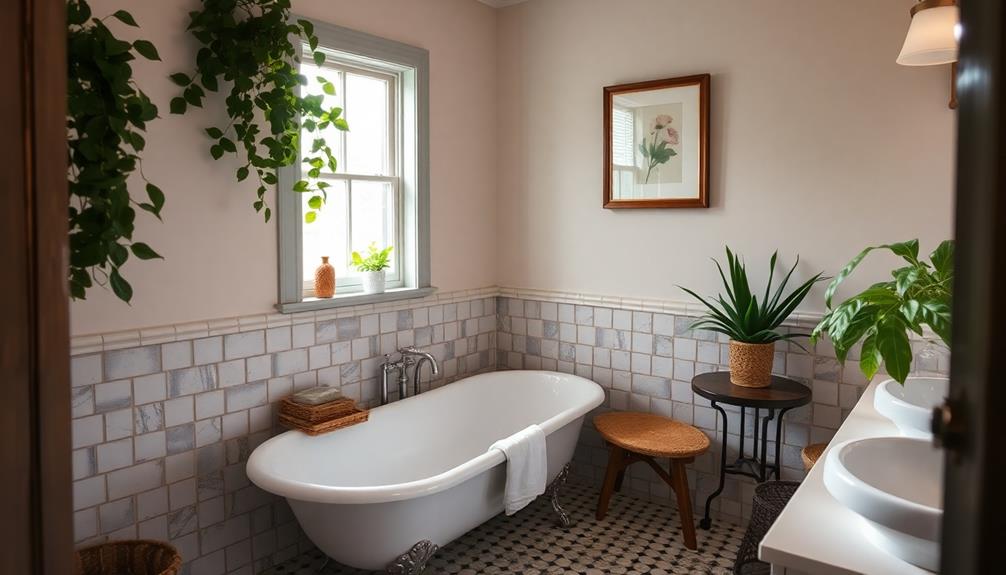
Personalization is what makes a bathroom truly yours, allowing you to express your style and preferences. To create a space that reflects your unique taste, consider these key elements for personalizing your space:
- Decor Items: Incorporate rugs, mirrors, and unique faucets to enhance the aesthetic appeal. These details can add character and charm.
- Living Plants: Adding greenery brings a natural element, but make sure to choose plants that thrive in your bathroom's light conditions.
- Color Selection: Opt for colors that resonate with you. Deep blues can evoke luxury, while vibrant hues can energize the space.
- Custom Storage Solutions: Tailored cabinetry or shelving not only optimizes space but also showcases your organizational style and preferences.
Additionally, don't forget to integrate smart devices, like programmable lighting and temperature controls, to modernize your bathroom experience.
By focusing on these areas, you'll design a space that's not only functional but also a true reflection of who you are.
Personalizing your space transforms your bathroom into a sanctuary where you can unwind and feel at home.
Utilizing Online Design Tools
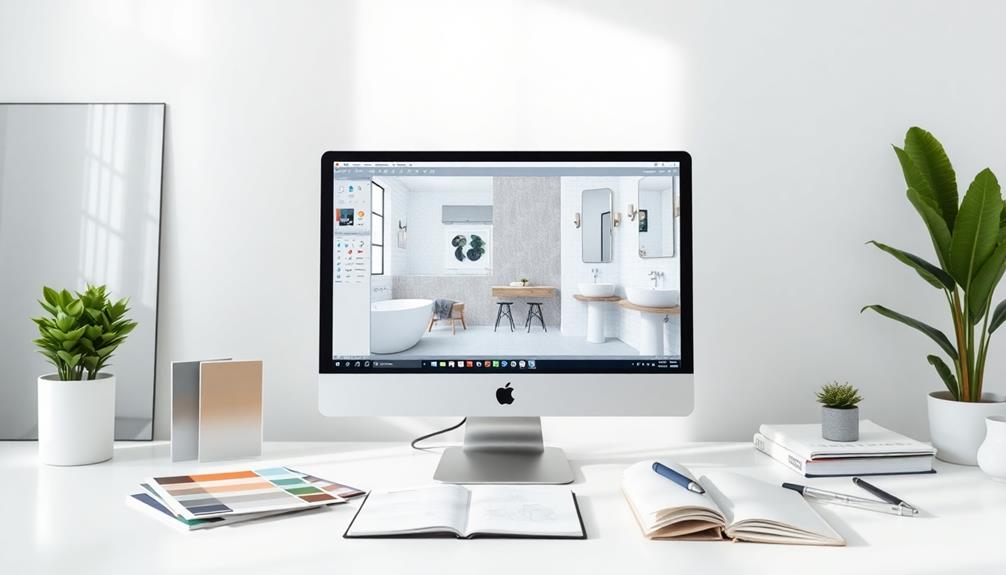
When you're ready to bring your bathroom remodel ideas to life, online design tools can be a game changer.
These platforms not only help you visualize your space in 2D and 3D but also make it easy to customize every detail.
Benefits of Online Design
In today's digital age, utilizing online design tools can transform your bathroom remodel into a more manageable and creative process. By embracing these platforms, you'll find several key benefits that make your project smoother and more enjoyable.
- Enhanced Visualization: Tools like RoomSketcher allow you to create detailed 2D and 3D floor plans, helping you visualize how your small space will look with different layouts and finishes.
- Clear Communication: These tools provide precise representations of your desired design, making it easier to communicate your vision to contractors and designers.
- User-Friendly Features: Most online design platforms come with drag-and-drop features, allowing even those with limited design experience to create stunning layouts effortlessly.
- Experimentation: You can digitally experiment with various fixtures and finishes, saving you time and resources by visualizing changes before making actual purchases.
With tutorials and resources available, you'll gain a better understanding of design principles, ensuring a more informed and satisfying remodeling experience.
Embrace online design tools and watch your bathroom remodel come to life with ease.
Tools for Visualization
Using online design tools for your bathroom remodel not only enhances your planning experience but also provides powerful visualization options. Tools like RoomSketcher enable you to create detailed 2D and 3D floor plans, allowing you to visualize your bathroom layout and design elements before diving into the remodeling process.
With intuitive drag-and-drop functionality, you can easily customize floor plans by adding walls, fixtures, and finishes that fit your specific dimensions and preferences.
One key advantage is the ability to experiment with different materials and finishes. You can apply these directly to virtual walls and floors, helping you understand how color schemes and textures will work together in your overall bathroom design.
Additionally, many platforms offer a gallery of pre-made bathroom designs, serving as inspiration and reference points during your planning.
Moreover, you can save and share your designs with contractors or designers, which enhances communication. This guarantees your design preferences are accurately conveyed and considered throughout the remodeling project.
Managing Unexpected Issues
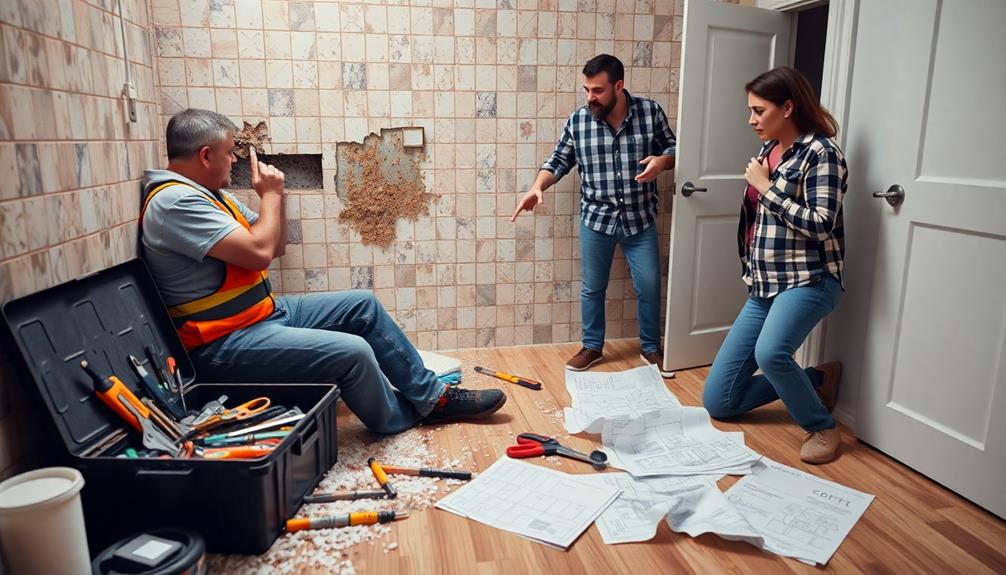
Unexpected issues can arise at any stage of your bathroom remodel, so it's vital to be prepared.
Whether you're installing a soaking tub or rerouting a water line, being proactive can save you time and money. Here are some tips to help you manage those unexpected challenges:
- Anticipate Delays: Material shortages can mess with your timeline. Be flexible and have a backup plan ready.
- Budget for Repairs: Sometimes, necessary repairs for water damage or leveling will pop up. Set aside extra funds for these surprises.
- Communicate with Your Contractor: Discuss any structural concerns, like sagging ceilings or plumbing issues. Clear communication helps avoid costly mistakes.
- Plan Temporary Solutions: Have a contingency plan for a temporary bathroom setup. An alternative shower can keep disruptions to a minimum.
Regularly reviewing the progress and quality of work is significant.
Catching issues early guarantees they're addressed before moving on to the next phase of your remodel.
With these strategies in place, you'll feel more confident steering through any unexpected twists during your bathroom transformation.
Frequently Asked Questions
Is There an App to Remodel Your Bathroom?
Yes, there are several apps available for remodeling your bathroom. You can use tools like RoomSketcher or Houzz to visualize layouts, experiment with fixtures, and even share your designs for feedback from others.
In What Order Should You Renovate a Bathroom?
Think of your bathroom as a puzzle; start by planning and budgeting. Then, demolish, tackle plumbing and electrical work, lay tiles, install fixtures, and finish with cabinetry and personal touches. Each step builds your dream space.
What Is the Most Expensive Part of a Bathroom Remodel?
The most expensive part of a bathroom remodel is usually labor costs, which can take up to 35% of your budget. High-end fixtures and intricate tile work also greatly contribute to your overall expenses.
How to Remodel a Bathroom Step by Step?
Start by evaluating your current layout and defining your goals. Create a budget, plan for demolition, coordinate plumbing and electrical work, then install fixtures, tiles, and paint, ensuring everything meets building codes before final inspections.
Conclusion
In the end, designing your bathroom remodel is all about envisioning your dream space, embracing innovative ideas, and executing your plan with precision. You've assessed your needs, explored design concepts, and tackled your budget. Now, it's time to select materials that inspire, add personal touches that reflect your style, and utilize tools that streamline the process. By staying organized and adaptable, you'll transform your bathroom into a sanctuary that's not just functional, but also uniquely yours.
